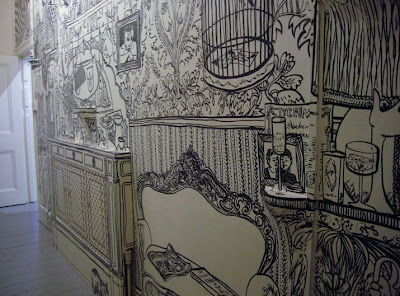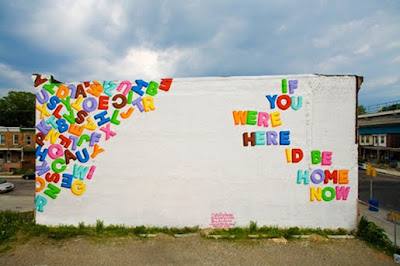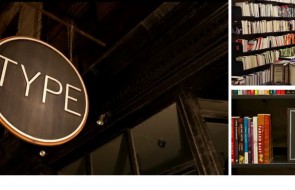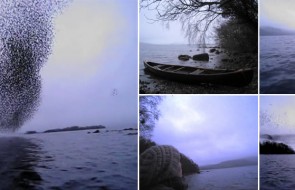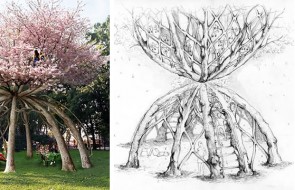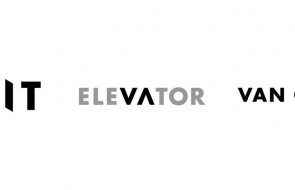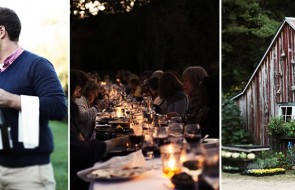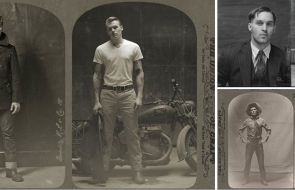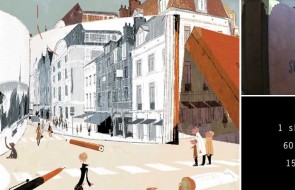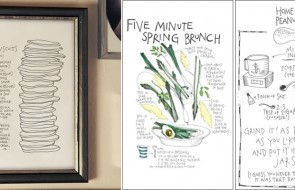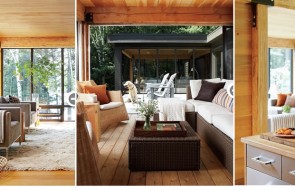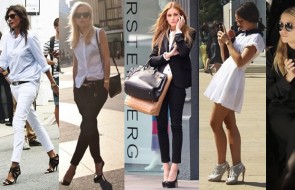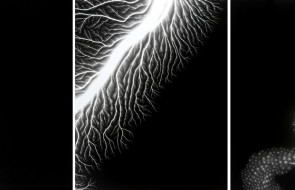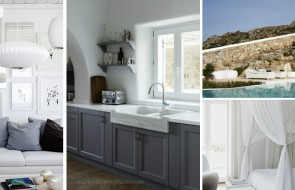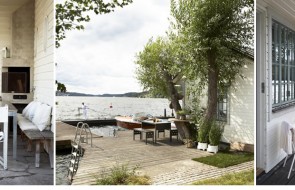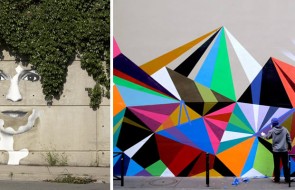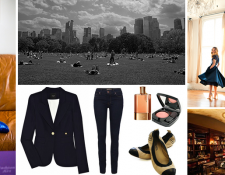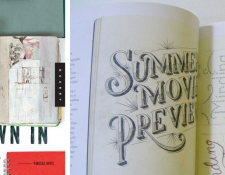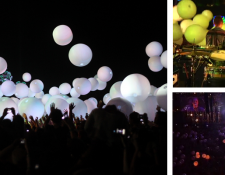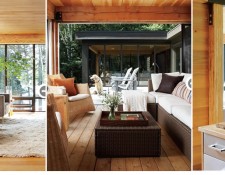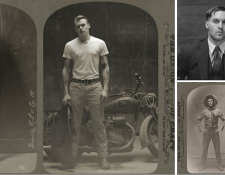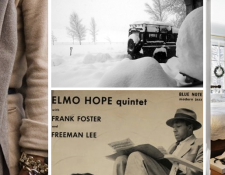Arts Visuels
Mann Takes it to the Wall

Charlotte Mann gives a new meaning to “mural,” as well as to “pen and ink drawing.” She takes her pen and ink directly to the wall, and makes a mural not depicting some unrelated subject matter, but rather, an imaginary version of what the wall could look like, or what the rest of the room could look like were there not a wall right there.
 (Click for a larger image.) For a Peter Jensen show, she created this backdrop using all images from Tina Barney’s photographs. According to her website, every detail, down to a cigarette pack, can be found in Barney’s book Theatre of Manners. Do check out Tina Barney as well, her photographs documenting her family and friends’ lives is fascinating.
(Click for a larger image.) For a Peter Jensen show, she created this backdrop using all images from Tina Barney’s photographs. According to her website, every detail, down to a cigarette pack, can be found in Barney’s book Theatre of Manners. Do check out Tina Barney as well, her photographs documenting her family and friends’ lives is fascinating.
 This room literally had a desk and a file cabinet and nothing else. She created quite a little world in ink! Love the details.. the barcelona chair, the Chanel book, the model helicopter…
This room literally had a desk and a file cabinet and nothing else. She created quite a little world in ink! Love the details.. the barcelona chair, the Chanel book, the model helicopter…
PS- Yes, that is a Lil’ Jon reference in the title.
Arts Visuels
LeWitticisms
Sol LeWitt’s Wall Drawing #1167, Dark to Light (2005) at the Venice Biennale
When you get as close as this guy did, you realize that the whole thing is made up of graphite scribbles.
I saw this at the Italian pavilion at the Venice Biennale (which I have an unending, and possibly even growing, obsession with) in 2007. This is interesting if you notice the date of the work, which is 2005. And it’s on the wall, it wasn’t brought in on a canvas… so it was executed in 2007, but the date is 2005.
That’s because LeWitt’s work was all about the idea, which he explained through written instructions and then handed off to others to execute. LeWitt was actually one of the artists who verbalized the premises behind Conceptual Art, and in his “Paragraphs on Conceptual Art,” he writes:
“When an artist uses a conceptual form of art, it means that all of the planning and decisions are made beforehand and the execution is a perfunctory affair. The idea becomes the machine that makes the art.” (Artforum, 1967)
So in 2005, he came up with the idea that became the machine that produced the art in 2007.
 Wall Drawing #1245 (2007), first installed at PaceWildenstein
Wall Drawing #1245 (2007), first installed at PaceWildenstein
His work in general raises all sorts of interesting issues regarding art that I won’t delve too far into here since this isn’t a class, but I can’t help but point out a few interesting things:
- The work is all scribbles, which are sort of the definition of “my kid could do that” art, but they are controlled scribbles, carefully planned and executed to create an overall effect. Unlike abstract expressionist art, this is emotionless and devoid of individualistic expression.
- Also, he doesn’t do the execution, breaking down the idea of the artist as a solitary genius and sole possessor of an intangible talent. However, it’s interesting to note that early Renaissance masters also had entire workshops of artisans execute their works.
- The work could be reproduced countless times, based on the instructions. But if it isn’t authorized by him, is it a copy? Or is it still art? Is it still valuable?
- Even though LeWitt said his art was not meant to be beautiful, there is something beautiful about the scribble pieces, and their visual power in person is surprising given the methodical, process-oriented nature of the work. I for one wanted to stand and stare for a while.
- Finally, I think it’s interesting how he was obsessed with pointing out the flatness of the picture plane, which in most cases is actually the wall. This is directly opposed to pre-Modern art, in which the artist wanted to create a believable representation of 3d space within the picture plane that looked like you could walk right into it. Instead, LeWitt is saying “Look, it’s just a wall.”
Arts Visuels
Nikki Flurry and Amy Salk

I want to have a costume party where everyone has to wear masks like this.

Well not really, as they are clearly art and not costume, but wouldn’t that look cool? I can actually imagine an entire masked ball in black where the only white are these masks. The photos would be amazing. Aren’t they beautiful?

These, and the pieces below, are all made of only paper. Above, the masks are by artists/designers/stylists/cool girls Nikki Flurry and Amy Salk. They say on their website that they are about the “grace and nuance of this humble material.” The pieces below are just by Nikki Flurry. (Aside: Nikki used to own Addiction boutique in Buckhead!)
Arts Visuels
Obliteration of Eternity
What you are looking at is a room of mirrors, lit with hundreds of candles hung on wires at different heights, with a shallow pool of water on the floor for an added layer of reflection (and disorientation, as the water ripples).
Installed at Gagosian Gallery in New York last summer, this work is by contemporary art doyenne Yayoi Kusama. Barely comprehensible in the above photos, the black and white gives a better sense of where the walls are, as you can see where they meet (and then meet again and then meet again and then meet again in all the reflections).
And guess what, you enter that after walking through this blank white room, and then the actual installation room is not very big at all!!
Watch this video for a better sense of the three dimensionality of the space and the effect of the glimmering light thrown off by the candles.
Infinity Room from mamojo on Vimeo.
How amazing is that?!! So simple, and yet so creative and other-worldly. Talk about transporting the viewer! (..or in this case the expiencer!)
Arts Visuels
Prints and the Revolution
Bold and graphic photos by Malick Sidibe, a photographer from Mali.

Would you believe the above three photos are from this year? Not only are they current, but the models (his family members) are all dressed head-t0-toe in clothes from designers’ African-inspired spring collections from last year, including Marni, Dries van Noten, Marc Jacobs, etc. It’s all about context, eh? Would you have ever guessed?
Shot for the NYT Style Magazine, “Prints and the Revolution” (I stole the title), April 2009. More photos there.
Click the jump for more…
Originally, however, he started out photographing parties in Mali in the 1950s and ’60s, a heyday in Mali when Western clothes were becoming popular.
Interesting that he would later shoot Western clothes adapted to an African look, when he started out photographing African people trying to adopt the Western styles.
Those girls are really cool, btw.. check out that girl’s long-sleeved supershort tunic on the left.
I don’t know anything about these final three, but they remind me so much of some of the portraits by a few of my favorite painters … perhaps Sidibe was a fan of art history and knew these paintings and was riffing on them?
 Manet’s Olympia – 1863 – This is uncanny, I can’t be imagining the similarities– seated women, ankels crossed protectively, each with a hand on their laps, both aware of the viewer’s gaze, addressing the gaze somewhat uncomfortably, surrounded by textiles… they even both include bouquets of flowers!
Manet’s Olympia – 1863 – This is uncanny, I can’t be imagining the similarities– seated women, ankels crossed protectively, each with a hand on their laps, both aware of the viewer’s gaze, addressing the gaze somewhat uncomfortably, surrounded by textiles… they even both include bouquets of flowers!

 Ingres’ Grande Odalisque – 1814 – again, similar composition, a stretched out seated woman leaning on a hand/elbow, with her back to us, knees bent, surrounded by textiles. Even notice the way the textile in the background of Sidibe’s bends sideways to meet her knee, just like the curtain in the background of Ingres’ meets the odalisque’s knee.
Ingres’ Grande Odalisque – 1814 – again, similar composition, a stretched out seated woman leaning on a hand/elbow, with her back to us, knees bent, surrounded by textiles. Even notice the way the textile in the background of Sidibe’s bends sideways to meet her knee, just like the curtain in the background of Ingres’ meets the odalisque’s knee.

 Matisse’s Robe Violette et Anemones – 1937 – and once again, a similarly composed portraits of a woman in a somewhat angular pose (notice elbows and knees), oriented vertically, figure takes up almost the whole picture plane– with the use of multiple patterns on walls, floors, and textiles, melding foreground and background.
Matisse’s Robe Violette et Anemones – 1937 – and once again, a similarly composed portraits of a woman in a somewhat angular pose (notice elbows and knees), oriented vertically, figure takes up almost the whole picture plane– with the use of multiple patterns on walls, floors, and textiles, melding foreground and background.
He MUST have been aware of these portraits, right??!
Arts Visuels
A Love Letter For You

LOVE this mural project, called “A Love Letter For You,” in Philadelphia spearheaded by Philadelphia-born artist Stephen Powers. Powers, who grew up in Philadelphia and used to use the neighborhood walls for graffiti, is now an artist with his work shown in places like the Venice Biennale (one of my favorite events ever) and the Institute of Contemporary Art in Philadelphia.
 Many of the messages and designs reference the original signs that might have been painted in those locations, like this one next to a barber shop.
Many of the messages and designs reference the original signs that might have been painted in those locations, like this one next to a barber shop.

Made to be viewed from the El train, the blog about the project captions each photo with a description of what train each mural can best be viewed from.
Who can resist a love letter?
Arts Visuels
Hello Picasso
I LOVE these fantastic photos of Picasso playing with light. They were inspired by work by Gjon Mili, who also photographed him here “drawing” with a small flashlight in a dark studio.
Via Cup of Joe and more cool photos from the series on Life‘s website.

And, they reminded me of a book I’ve been wanting – Goodbye Picasso by David Douglas Duncan. It’s an intimate look at Picasso in his studio and home. The cover is a self-portrait by Picasso of himself as an owl done in ink with a photograph of his eyes collaged in.

From the bookjacket:
“[The book contains a selection of] tens of thousands [of photos] taken during the next seventeen years when David Douglas Duncan often shared the simple meals, the constant work, the gaiety, the countless explosions of creativity.
After other guests had gone, Duncan still remained in the studio — by now his second home. Thus was born a friendship unique in the lives of both men. Two minds, two hearts, each discovering a special communication with the other.
While photographing hundreds of Picasso’s paintings, surrounded by myriad other works that overflowed the studio, Duncan also recorded many of the emotion-charged events at the heart of the household.”
 Picasso sparring with his son Claude.
Picasso sparring with his son Claude.
 Picasso and Jacqueline, Picasso showing his dear Lump a plate he has made bearing his portrait.
Picasso and Jacqueline, Picasso showing his dear Lump a plate he has made bearing his portrait.
 His studio at Villa la Californie, full of his works just propped here and there. Notice Les Demoiselles d’Avignon (image below), 1907, in the background. This shot gives a good sense of how big it is! This photo was taken in 1960– I didn’t realize this painting remained in his private collection that long. It now hangs in the Moma. Or maybe this was a sketch for it? The ground looks much darker than in the image below, but maybe that’s just the lighting. Also, I love the textile draped on the rocker by Jacqueline.
His studio at Villa la Californie, full of his works just propped here and there. Notice Les Demoiselles d’Avignon (image below), 1907, in the background. This shot gives a good sense of how big it is! This photo was taken in 1960– I didn’t realize this painting remained in his private collection that long. It now hangs in the Moma. Or maybe this was a sketch for it? The ground looks much darker than in the image below, but maybe that’s just the lighting. Also, I love the textile draped on the rocker by Jacqueline.
 His own collection included works by Matisse, Degas, Modiglianis, Cezanne, etc.
His own collection included works by Matisse, Degas, Modiglianis, Cezanne, etc.
 A rare posed-looking shot amongst mostly intimate, casual candids. Also, I love that he seems to be shirtless (and/or pantsless) most of the time. The more photos I looked through, the more apparent this became. His total comfort with partial nudity, combined with his often very engaged, active stances, gives him such a vital and alive loo
A rare posed-looking shot amongst mostly intimate, casual candids. Also, I love that he seems to be shirtless (and/or pantsless) most of the time. The more photos I looked through, the more apparent this became. His total comfort with partial nudity, combined with his often very engaged, active stances, gives him such a vital and alive loo
k, like he was just bursting at the seams with creativity.
Arts Visuels
If these walls could talk
Interesting what art preferences say about a president… Bush chose all Texas landscapes for the Oval Office, and Obama is calling for abstract art. Change, indeed.
Read a full report on the President’s plans for revamping the White House art collection here.
Via Style Court.

